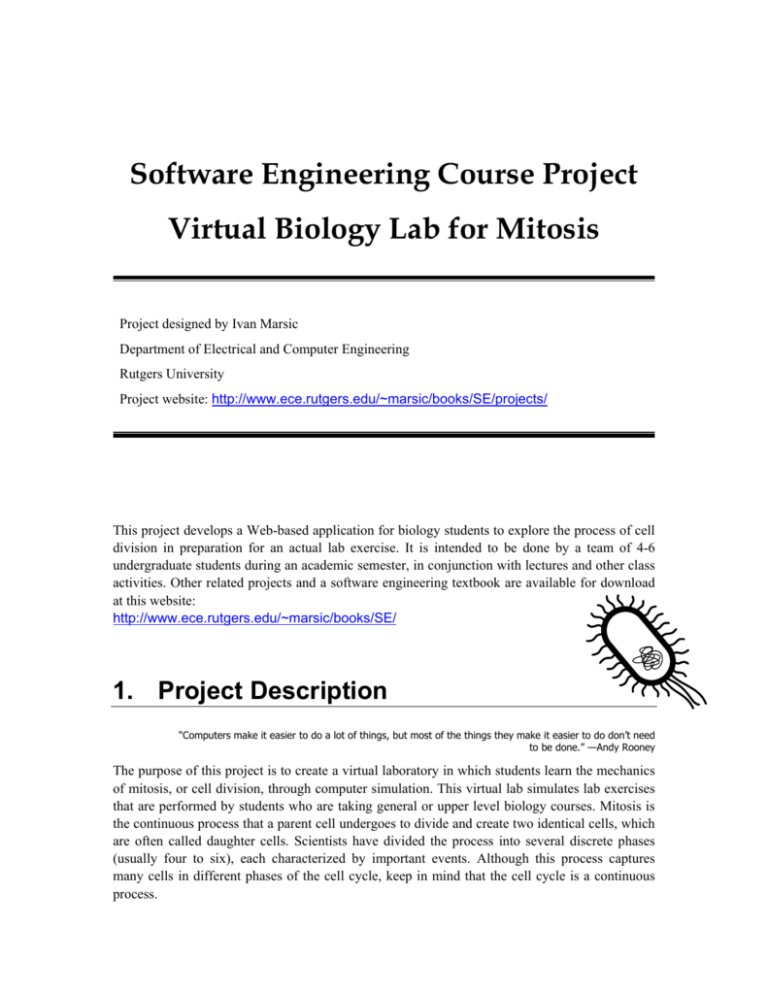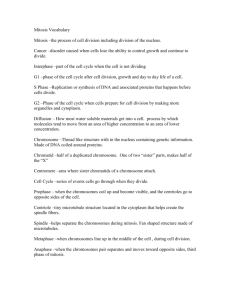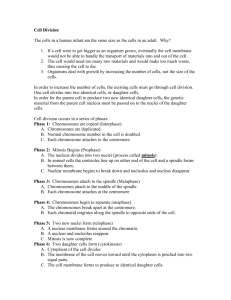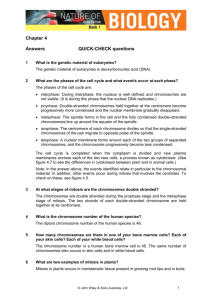Software Engineering Course Project Virtual Biology Lab for Mitosis
advertisement

Software Engineering Course Project Virtual Biology Lab for Mitosis Project designed by Ivan Marsic Department of Electrical and Computer Engineering Rutgers University Project website: http://www.ece.rutgers.edu/~marsic/books/SE/projects/ This project develops a Web-based application for biology students to explore the process of cell division in preparation for an actual lab exercise. It is intended to be done by a team of 4-6 undergraduate students during an academic semester, in conjunction with lectures and other class activities. Other related projects and a software engineering textbook are available for download at this website: http://www.ece.rutgers.edu/~marsic/books/SE/ 1. Project Description “Computers make it easier to do a lot of things, but most of the things they make it easier to do don’t need to be done.” —Andy Rooney The purpose of this project is to create a virtual laboratory in which students learn the mechanics of mitosis, or cell division, through computer simulation. This virtual lab simulates lab exercises that are performed by students who are taking general or upper level biology courses. Mitosis is the continuous process that a parent cell undergoes to divide and create two identical cells, which are often called daughter cells. Scientists have divided the process into several discrete phases (usually four to six), each characterized by important events. Although this process captures many cells in different phases of the cell cycle, keep in mind that the cell cycle is a continuous process. Ivan Marsic Rutgers University 2 The key challenges in this project are: 1. Realistic simulation of the actual lab: The design described in Section 1.2 shows only a “success scenario” for developing the virtual lab. This design rigidly drives the student through a sequence of steps to a successful completion of the lab. However, in a real lab the student can make mistakes or follow “blind alleys.” To support student learning, the virtual lab should mimic the real world, allow the student to make the same mistakes and then recover from the mistakes and successfully complete the lab. 2. Grading based on tracking the student’s performance: All student actions should be tracked and summarized in a single number that reflects his or her understanding of the lab material. This number will be presented to the biology course instructor for grading. The developers should look for ingenious ways to tackle these challenges. Before the developer will be able to do so, the first step is to learn a bit about the problem domain. Here is a brief summary, but the developer should seek other sources on the Web and in the local library. Ideally, the developer should visit the local biology department and talk to the instructors and students to better understand the problem (see Section 1.3). 1.1 Domain Description: Cell Mitosis The state between two successive divisions is called interphase. In interphase, the cell is engaged in metabolic activity and performing its duty as part of a tissue. The DNA duplicates during interphase to prepare for mitosis (the next four phases that lead up to and include nuclear division). Chromosomes are not clearly discerned in the nucleus, although a dark spot called the nucleolus may be visible. During mitosis, the chromosomes in the dividing cell’s nucleus go through the following series of stages (see Figure 1): 1. Prophase—Chromatin in the nucleus begins to condense and becomes visible in the light microscope as chromosomes. The nuclear membrane dissolves, marking the beginning of prometaphase. Proteins attach to the centromeres creating the kinetochores. Microtubules attach at the kinetochores and the chromosomes begin moving. 2. Metaphase—The spindle fibers align the replicated chromosomes at the center of the cell (equatorial plate). This organization helps to ensure that in the next phase, when the chromosomes are separated, each new nucleus will receive one copy of each chromosome. 3. Anaphase—The paired chromosomes separate at the kinetochores into two daughter chromosomes, which are moved by the spindle to opposite ends of the cell. Motion results from a combination of kinetochore movement along the spindle microtubules and through the physical interaction of polar microtubules. 4. Telophase—New membranes form around the daughter nuclei while the chromosomes disperse and are no longer visible under the light microscope. Cytokinesis or the cytoplasmic division of the cell occurs at the end this stage. The reader should understand that this is a very complex process and the above description highlights only the key stages. Here I present a simple model of the mitotic process that is inspired by the laboratory exercises performed by biology students. In the real lab, the students Software Engineering Course Project 3 Virtual Biology Lab for Mitosis 1. PROPHASE 2. METAPHASE Parent cell Cytoplasm Dispersing nucleolus Developing bipolar spindle Centromere with attached kinetochores Spindle pole NUCLEAR ENVELOPE BREAKS DOWN Plasma membrane Nuclear envelope vesicles Chromosomes aligned at the equatorial plate Kinetochore microtubule Aster defining one pole of the spindle Intact nuclear envelope Spindle pole Condensing chromosome with two sister chromatids held together at centromere 4. TELOPHASE Two daughter cells 3. ANAPHASE Polar microtubules SISTER KINETOCHORES SEPARATE; CENTROMERES DIVIDE NUCLEAR ENVELOPE RE-FORMS; CHROMATIN EXPANDS; CYTOPLASM DIVIDES Reappearing nucleolus Completed nuclear envelope surrounding decondensing chromosomes Midbody: region of microtubule overlap Contractile ring creating cleavage furrow Kinetochore microtubules shorten as chromatid is pulled toward the pole Elongating polar microtubule Constricted remains of polar spindle microtubules Re-formation of interphase array of microtubules nucleated by the centrosome Shortening kinetochore microtubule Centriole pair marks location of centrosome Astral microtubule Figure 1: The stages of cell division (mitosis). Adapted from B. Alberts, D. Bray, J. Lewis, M. Raff, K. Roberts, and J. D. Watson, Molecular Biology of the Cell, 2nd Edition, Garland Publ., Co., 1989. are given plastic beads and a cylindrically shaped magnet called a “centromere.” When these parts are assembled, they form the model for a chromosome. The students are asked to build four of these, one red pair, and one yellow pair. Finally, the students enact the behavior of the chromosomes during the stages of mitosis. 1.2 Customer Statement of Work Recall that our goal is to help the student to understand and memorize the key aspects of mitosis. Each phase of mitosis is described by a sequence of steps in the lab. The lab begins with one cell on the screen, containing a nucleus, a red chromosome, and a yellow chromosome. The student is taken through various phases of cell division, in which he/she observes an animation of the phase, or is prompted to perform tasks needed for completing the phase. The student is required to complete each phase before advancing to the next phase. The program should be available online so that students can access it from any place at any time. The simulation progresses as follows (see Figure 2). Notice that for every stage there should be suitable textual information provided to orient the user of the current state of simulation the let them know what kind of work the system expects them to do before progressing to the next stage. Increasing separation of the poles Ivan Marsic Rutgers University 4 Step 0a (Build Parent Cell). Before beginning the simulation of mitosis, the parent cell should be assembled. The user does this with a set of “beads” (small oval shapes), two centromeres, two strings (guidelines) to hold the beads, and the cell plasma and nucleus. The centromere and all beads of one color should be threaded on one string to make one chromosome, and the centromere and beads of the other color should be threaded on the other string. To thread a bead on the string, the user clicks on the bead, drags it to an approximate final location and releases the mouse button. The program should find the closest available “slot” and snap the bead to the slot. The assembling of the chromosomes should be possible to interleave, so the user can partially build one chromosome, then part of the other, then switch back to work on the first one, etc. The centromere must be threaded first, and all beads of its color are disabled before the centromere is in place. After a chromosome is completed, its guideline should automatically disappear. Assuming that the bead diameter is 10 pixels, the centromere ellipse is 20 10 pixels, the nucleus diameter is 200 pixels, and the cell diameter is 400 pixels. Initially, the beads should be scattered around, and they should come in two colors (red and yellow). Select a reasonable threshold distance for snapping the centromeres and the beads. After building the cell, the user clicks “Next” button to proceed to the next step. The user should not be allowed to advance before the cell is properly built. A message is displayed telling the user he has not completed the requirements of the stage and must complete them before proceeding. Note: A secret key combination, say Ctrl-b, should be programmed to allow for automatic building of the chromosomes, to shorten the process if needed. Step 0b (Interphase). This phase is not part of mitosis—it occurs before mitosis begins. During this phase, the chromosomes duplicate themselves. Thus, the system should automatically duplicate the chromosomes and let the mitosis process start. The user clicks “Next” button to enter the first phase of mitosis. Step 1 (Prophase). In prophase, the chromosomes become increasingly easier to visualize as they become thicker and shorter as prophase progresses. For the simulation however, the chromosomes will remain the same. At the end of prophase the nuclear envelope disappears. The user clicks “Next” button to remove the nucleus (the state indicator still shows “Prophase”). To remove the nucleus, the system uses animation: the nucleus dissolves into the cell and fades away while becoming larger. This is the end of prophase; it is also known as prometaphase. The user clicks “Next” button to proceed into metaphase. Step 2 (Metaphase). In metaphase, the chromosomes line up in the central region of the cell at the equatorial plane. At the beginning of this phase, a guideline automatically appears to indicate the equatorial plane. The user is asked to click and drag the two chromosomes over to the guideline. The user should click and drag the yellow chromosome to the upper portion of the guideline; then, click and drag the red chromosome to the lower portion of the guideline. After the chromosomes are positioned at the equatorial plane, the guideline automatically disappears. The system should snap chromosomes the only if they are close to their final position. Otherwise, the chromosomes would be left wherever the mouse button is released. A dialog box should post a warning if the user tries to advance while the chromosomes are mispositioned. Software Engineering Course Project 5 Virtual Biology Lab for Mitosis Step 0a: Build the parent cell Parent cell Guidelines Cell Nucleus Beads Next Centromeres Step 0b: Interphase Step 1: Prophase Next Next Animation: The nucleus dissolves into the cell cytoplasm Next Step 2: Metaphase Equatorial plane Spindle fibers Next Next Figure 2: Simulation of the mechanics of cell division. (continued below) The user clicks “Next” button to proceed (the state indicator still shows “Metaphase”). The centromeres of each sister chromatid become attached by spindle fibers to opposite poles of the cell. The lines representing the spindle fibers should appear now, but they should be disabled, so the user cannot manipulate the chromosomes. The user clicks “Next” button to proceed into anaphase. Ivan Marsic 6 Rutgers University Step 3: Anaphase Manipulated centromere Next Step 4: Telophase Animation: Nucleus condenses from the cytoplasm and the cell splits in two Next Figure 2: (continued) Simulation of the mechanics of cell division. Step 3 (Anaphase). The sister centromeres move to opposite poles and the attached chromatids are carried along, trailing out behind in a V-shape. The user should carry out the movement of the chromosomes by mouse manipulation. The spindle fibers become enabled to allow the user to manipulate chromosomes on screen. The user should click on a centromere and drag it towards the end of its spindle fiber. Only an outline is shown for the centromere that is interacted with. As a chromosome is pulled away by the user, it bends with the direction of movement. The chromosome opposite to it mirrors this action and moves in synchrony. A series of parabolas were used to model the changing shape of the chromosome as it is being pulled. (See discussion below on how to draw the parabolas.) Software Engineering Course Project 7 Virtual Biology Lab for Mitosis Interaction point Spindle S y (a) (b) db db Chromosome Displacement x Figure 3: Chromosome manipulation. (a) Initial shape. (b) Displaced along the spindle. The user can release mouse button at any time and the chromosomes would freeze in the current position. The user can resume later from where they stopped, until the chromosomes are brought to the poles of the cell. The system should allow swinging the chromosome back and forth, not only in one direction (towards the pole). The user clicks “Next” button after the chromosomes have been properly placed. Step 4 (Telophase). In telophase, the spindle fibers disappear, the chromosomes start to decondense (not shown in the simulation), and two nuclear envelopes form. The user should click “Next” to watch the cell divide into two separate cells. Animation of the cell splitting and forming two nuclei is displayed. This concludes the process of mitosis. In anaphase (Step 3 above), as a chromosome is pulled away by the user, it bends with the direction of movement. The chromosome opposite to it mirrors this action. A series of parabolas were used to model the changing shape of the chromosome as it is being pulled. Let us consider that the right chromosome is being manipulated (dragged horizontally to the right). If x represents the amount of displacement in the horizontal axis, then the vertical displacement is represented by y, as in: x = a y2, where 0 a 1 (P1-1) Initially, the shape of the chromosome is a straight line, so the curvature a = 0. When the chromosome is pulled all the way to the end of the spindle fiber, a = 1. As the user drags the centromere to the right, the line begins to curve, so the curvature of the parabola depends on the x-position of the centromere. For the animation to look correct, the individual beads must remain equidistant from each other on the curve as the curvature changes (see Figure 3). In other words, if two adjacent beads are db units apart when the chromosome is in its initial straight line position, when the chromosome reaches its final position, the distance on the curve, or the arclength between the two adjacent beads should remain db units. To find the position of each of these beads, the arclength equation for (P1-1) must be known to calculate the x and y positions of the beads. Ivan Marsic 8 Rutgers University The equation for the arclength of a function f(y), which in our case is f(y) = a y2, equals: S 2 df ( y ) dy 1 dy From the table of integrals, we find that 1 4a y dy 2a 2 2 b 2 y 2 dy 2 1 2 y dy 2a y b2 b 2 y 2 ln y b 2 y 2 C 2 2 and in our case b = 1/2a. Finally, we obtain: 2 2 1 1 1 S a y y2 ln y y 2 4a 2a 2a (P1-2) For every x-position the centromere is dragged along the spindle fiber, a corresponding parabolic shape is calculated. This calculation gives the parameter a. The parameter S, which is different for each bead, is the distance from the center of the centromere to the center of the particular bead along the line or curve. For each bead S should remain constant regardless of the amount of the chromosome bending. With these two values, the y-position of the particular bead can be calculated by using (P1-2), and the corresponding x-position can be calculated by using (P1-1). 1.3 Domain Fieldwork Most of the fieldwork is already done, but the student may visit the local biology department and discuss with the instructors about possible enhancements and alterations to make it more suitable for their educational goals. It may be helpful to consult a cell biology textbook to gain better understanding of the cell division process. 1.4 Technologies to Be Used Macromedia Flex should be used for programming, so that the virtual lab can be loaded in any browser that has Macromedia Flash plug-in. Another option is to use Java 2D and implement the lab as a Java Applet. 2. Extensions Before considering any of the extensions suggested below, the developer should first ensure that the two key challenges listed at the beginning of this document are properly tackled. By comparing Figure 1 and Figure 2, the reader will note that the basic simulation described above grossly oversimplifies the mitotic process. More ambitious students should consider adding more details to the simulation, perhaps in consultation with the biology department faculty. For example, one might add telomeres to the chromosomes.1 1 Telomeres are to chromosomes what plastic caps are to shoelaces—they stop them fraying at the ends. Software Engineering Course Project Virtual Biology Lab for Mitosis 9 The above design does not support “Back” button to allow the user to step back during the simulation. The process is linear and does not allow for branching. To enhance the educational value of the lab, the developer may allow the user to make mistakes and go along a wrong branch, then retract and figure out where to make the correct turn. An instructor may want to know which stages of the mitosis process present the greatest difficulty for the student, so to give it greater coverage in the lectures. Hence, the system could be extended to maintain statistics about the number of errors the students perpetrate in each step. If a student tries to skip the current stage before completing it or performs actions incorrectly, this is recorded in a database at a server. The error statistics would be made available to instructors. Another extension is to model the process of meiosis which involves two mitotic divisions. 3. Additional Information Any cell biology textbook contains description of the mitosis process. There is also a great deal of online information. Some examples are given at this project’s website. Additional information about this project can be found at the project website, http://www.ece.rutgers.edu/~marsic/books/SE/projects/. Also, project reports along with running software developed by students at Rutgers University are available for download at this website. See also Problems 2.10 and 3.3 at the end of Chapters 2 and 3, respectively, the solutions of which can be found at the back of the book. The reader may also find useful information in this article: R. Subramanian and I. Marsic, “ViBE: Virtual biology experiments,” Proceedings of the Tenth International World Wide Web Conference (WWW10), Hong Kong, pp. 316-325, May 2001. Online at: http://www.ece.rutgers.edu/~marsic/publications/www10/








